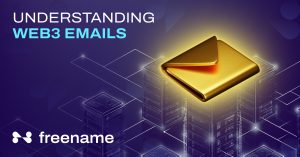ICANN vs. Web3 Registrars

Let’s say you want to start a Web 3 business. What would be the first step? Registering a website. But what TLD (top-level domain) would you choose? ‘.com’ or ‘.eth’? How will you make yourself stand out from the rest of the competition?
To answer this, let’s understand the difference between Web 2 and Web 3 registrars.
What is ICANN?
ICANN (Internet Corporation of Assigned Names and Numbers) standardizes and maintains the naming system. ICANN acts as a central repository for all IP addresses. They also manage a registry of DNS (domain name registrars). When you search for “google.com” a DNS lookup procedure takes place. A DNS resolver looks for the TLD associated (“.com”) and finds the relevant IP address. That IP address is equivalent to “google.com”. Any registrar (certified by ICANN) can sell domains at any price. ICANN runs a system of checks and balances to ensure everything is going according to its rules and regulations. In exchange, they charge a set fee.
Problems with ICANN
Excessive costs. Applying for a new TLD (for a 10-year period) will run you $185,000 along with a $25,000 annual fee.
Scalability. ICANN has not accepted any new applications since 2012 and doesn’t plan to until 2025 or later. Their model can’t scale to the domain name needs of the Web 3 industry. They also have limited growth to only 1,000 new extensions to TLDs.
Centralization. ICANN calls the shots. They set the rules and regulations. They also collect all the royalties and charge a transaction fee of $0.25.
How ICANN controls the Internet
ICANN now manages the master keys to the DNS registry – the Internet. Only 14 individuals, chosen from different countries, have the backup of these keys (extremely centralized). Every quarter, ICANN holds a highly confidential “Root Signing Ceremony”. This may seem surreal given that these meetings have windowless rooms and steel doors that require biometric scans, PIN codes, and smartcards to open. Recently, a new cryptographic key was generated by a single high-security computer and it was sent to ICANN’s chosen firms. Can you see the problem here? What if one of these firms were to be compromised? Would that be the end of the internet as we know it?
Web 3 firms, like Freename.io, aim to remove the centralization of domain name registries and the problems ICANN brings. Freename.io democratizes this industry by utilizing blockchain-based infrastructure. Their multichain approach allows them to rely on peer-to-peer networks that don’t need a central body to verify (or issue) domain names.
Will Web 3 make ICANN obsolete?
Not necessarily. It is important to understand that Web 3 firms like Freename.io are not directly competing with ICANN. Web 3 cannot be regulated by ICANN. Their scope of influence is limited to the Web 2 DNS. The one advantage that ICANN held is its power to regulate and avoid scams such as brand identity theft when two or more people try to register the same domain. However, this advantage seems to be eroding. Better regulations and further development of blockchain infrastructures have helped ensure that no single name is repeated, registered, or minted twice.
It is no news that big brands like Microsoft are filing new trademarks by the day. Creators and businesses can show that they “get it” by securing their brand, thanks to Web 3 TLD providers like Freename.io. You could go register with third-party branded domain extensions like “.eth” and “.sol”. But would your brand’s identity be consistent with these extensions?
Freename.io aids you in acquiring/maintaining your domain name and TLD. They further empower users by generating income through royalties. Once a user buys a blockchain domain, they have full ownership over it. Users also pay no fees! There are no ICANN renewal fees/policies imposed.
What are other benefits Freename.io bring that Web 2 registrars don’t?
- Freedom: There is no centralized body breathing down your neck while taking their commissions.
- Full Ownership: your domain, your property. You have complete ownership after you mint your domain. It is all recorded on the blockchain 🙂
- Passive income: Freename.io lets you activate the Royalty license. Whenever someone registers their domain on your TLD, you get 50% of the transaction. Already have a TLD? Learn how to activate your license here.
- Smart Investment: Domains and TLDs will only go up in price as adoption increases.
Web 3 registrars are filling up the market demand that ICANN and Web 2 registrars cannot. They may not seem to be in direct competition. Yet, it is becoming apparent that the shift to Web 3 is inevitable. This is where Web 3 registrars like Freename.io are empowering users and leading the industry.







